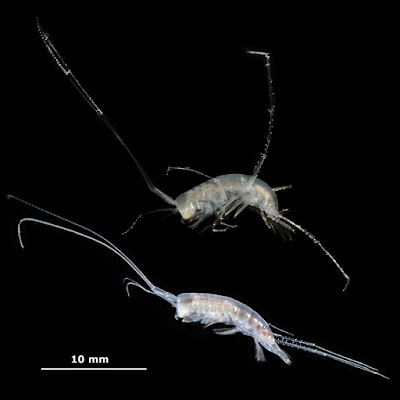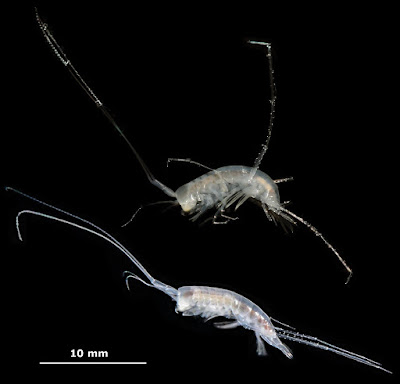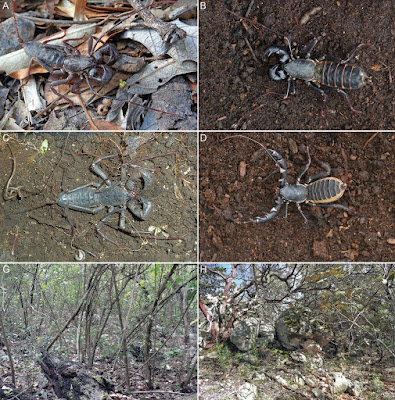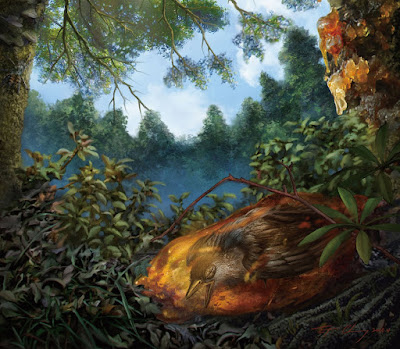[Most Recent Entries] [Calendar View]
Wednesday, February 7th, 2018
| Time | Event | ||||
| 2:54a | [Crustacea • 2018] Mayaweckelia troglomorpha • A New Subterranean Amphipod Species (Amphipoda, Hadziidae) from Yucatán State, México
Abstract A detailed description of a new stygobiont species of the amphipod family Hadziidae, Mayaweckelia troglomorpha Angyal, sp. n. is given, based on material collected in four cenotes of Yucatán federal state, México. Morphology was studied under light microscopy and with scanning electron microscopy. Morphological description is complemented with mitochondrial cytochrome c oxidase subunit I (COI) sequences as barcodes, with affinities to the related taxa and with notes on the species’ ecology. Using COI Bayesian inference and genetic distance analyses, we show that the closest relative of the new species is M. cenoticola, forming a monophyletic group referring to the genus Mayaweckelia. Based on the available sequences, we also revealed that Mayaweckelia and Tuluweckelia are sister genera, standing close to the third Yucatán subterranean genus, Bahadzia. The data gathered on the habitat, distribution, abundance, and ecology will contribute to the conservation planning for M. troglomorpha Angyal, sp. n. Keywords: cenote, description, endemic, Hadziidae, mitochondrial marker, morphology, SEM, sinkhole, subterranean Taxonomy Order Amphipoda Latreille, 1816 Suborder Senticaudata Lowry & Myers, 2013 Family Hadziidae S. Karaman, 1943 Genus Mayaweckelia Holsinger, 1977 Mayaweckelia troglomorpha Angyal, sp. n. Diagnosis: Medium-sized, eyeless hadziid with conspicuous troglomorphic traits. The first antenna almost twice as long as body and three times as long as the second antenna; gnathopod I propodus palm armed with distally notched spine teeth, carpus more than 1.5 times as long as corresponding propodus, merus as broad as but shorter than carpus, ventrally produced lobe with three long sensory setae; gnathopod II propodus twice as long as propodus I, palm armed with unnotched spine teeth, carpus slightly shorter than propodus on males. Dactylus, propodus. and carpus of pereopods VI-VII extremely long; therefore, pereopods VI and VII are 1.3 times as long as body length; epimeral plates I-III ventro-posterior corner tiny but distinct, ventral margin without robust setae, posterior margins concave; surfaces of uropods I-III pubescent; telson lobes each possess five-six robust setae and one-three slender setae on outer margin and six-seven robust setae on inner margin. Largest males and females both measured 10 mm. Etymology: The name troglomorpha refers to the highly adaptive troglomorphic features of the new species, particularly the elongation of appendages, the increased number of sensory setae and papillae, and general appearance of fragility. Gender feminine. Distribution and remarks on ecology: The new species is known from four cenotes in the state of Yucatán, covering a distribution distance of 52 km (distance between the farthest cenotes Dzonbakal and Xaan). All the individuals were found in fresh water habitat, in most cases far from the cenote entrances, deeper in the associated cave passages, where sunlight does not penetrate. Water temperature was between 26 and 27 °C. Specimens were collected between 20 and 33 meters depth; in cenote Kankirixché some individuals were observed below 45 meters depth. The new species was represented in all four localities with low abundance, though it proved to be more common and more abundant than M. cenoticola, of which a single specimen was found in only one (Ayun-Nah) of the 14 visited cenotes, during an underwater waste collecting activity, hidden in a plastic soft drink bottle. In the type locality and in cenotes Xaan and Kankirixché the new species co-occurred with the hadziid amphipod Tuluweckelia cernua. Other co-occurring stygobiont macro-crustaceans (in the four cenotes) were the mysid Antromysis cenotensis Creaser, 1936, the stygiomysid Stygiomysis cf. holthuisi (Gordon, 1958), the isopods Creaseriella anops (Creaser, 1936) and Yucatalana robustispina Botosaneanu & Iliffe, 1999, and the decapods Typhlatya mitchelli Hobbs & Hobbs, 1976, Typhlatya pearsei Creaser, 1936, and Creaseria morleyi (Creaser, 1936). .... Conclusions: To date, only a small proportion of the cenotes and other aquatic hypogean ecosystems have been studied in Yucatán state in zoological aspect. Our expedition has led to the discovery of a new species of subterranean hadziids, which confirms that exploration and further studies of the region’s groundwater Crustacea diversity is necessary. Description of the new species was completed with comparative scanning electron microscopy, which was used for first time on Mayaweckelia. It proved to be a rather useful method for discovering, analysing, and illustrating barely visible diagnostic characters. As contributions to the future molecular genetic studies on Yucatán subterranean hadziids, COI sequences as barcodes of M. troglomorpha sp. n., M. cenoticola, and T. cernua are now publicly available in GenBank. The phylogenetic studies have shown that based on the available sequences, the closest relative of the new species is M. cenoticola. In accordance with the previous cladistic studies, Mayaweckelia and Tuluweckelia prove to be sister genera, closely related to Bahadzia, the third Yucatán subterranean Hadziidae genus. This knowledge may contribute to the species’ future conservation planning. Dorottya Angyal, Efraín Chávez Solís, Benjamín Magaña, Gergely Balázs and Nuno Simoes. 2018. Mayaweckelia troglomorpha, A New Subterranean Amphipod Species from Yucatán State, México (Amphipoda, Hadziidae). ZooKeys. 735; 1-25. DOI: 10.3897/zookeys.735.21164 | ||||
| 6:11a | [Arachnida • 2018] Systematic Revision of the Giant Vinegaroons of the Mastigoproctus giganteus Complex (Thelyphonida: Thelyphonidae) of North America ABSTRACT The North American vinegaroon, Mastigoproctus giganteus (Lucas, 1835), is demonstrated to comprise a complex of range-restricted species rather than a single widespread polymorphic species. Seven species are recognized based on morphological characters of the adult males, including the arrangement of spines on the prodorsal margin of the pedipalp trochanter, the position of the epistoma on the carapace, the presence of a stridulatory organ on opposing surfaces of the chelicerae and the pedipalp coxa, the presence of a patch of setae on sternite V, and the shape and macrosculpture of the retrolateral surface of the pedipalp femur. The two currently recognized subspecies are elevated to species: Mastigoproctus mexicanus (Butler, 1872), stat. nov., and Mastigoproctus scabrosus (Pocock, 1902), stat. nov. Mastigoproctus floridanus (Lönnberg, 1897) is revalidated from synonymy with M. giganteus. Redescriptions of M. giganteus and the other three species, based on both sexes, are provided, and three new species described: Mastigoproctus cinteotl, sp. nov., from Tamaulipas, Mexico; Mastigoproctus tohono, sp. nov., from Arizona and Sonora, Mexico; Mastigoproctus vandevenderi, sp. nov., from Sonora, Mexico. The present contribution raises the diversity of the Order Thelyphonida Latreille, 1804, in North America from one species to seven. Three species occur in the United States (one each in Arizona, Texas, and Florida), six species occur in Mexico, and two species occur in both countries. Keywords: Arachnida, Uropygi, whip scorpion, biodiversity Diego Barrales-Alcalá, Oscar F. Francke and Lorenzo Prendini. 2018. Systematic Revision of the Giant Vinegaroons of the Mastigoproctus giganteus Complex (Thelyphonida: Thelyphonidae) of North America. Bulletin of the American Museum of Natural History. 418; 1-62. DOI: 10.1206/0003-0090-418.1.1 | ||||
| 9:42a | [Botany • 2016] Begonia titoevangelistae • A New Species (Begoniaceae, sect. Baryandra) from Catanduanes Island, the Philippines
Abstract Begonia titoevangelistae from Nahulugan Falls, Gigmoto, Catanduanes Island is described as a new species endemic to the Philippines. It resembles Begonia neopurpurea but is distinguished by the variegated leaves where the veins and midrib are dark green to almost black contrasting with light green interveins in the adaxial surface. In the abaxial surface, the veins are maroon contrasting with cream interveins, and its wide obliquely ovate leaf is elongated with shallowly undulate and minutely lobed leaf margin and long acuminate apex. Based on International Union for the Conservation of Nature red list criteria, B. titoevangelistae was assessed to be critically endangered, since it consists of one population with 300 individuals on a 100 m area around the waterfalls, which is being developed into a tourist spot. Keywords: Begonia, Catanduanes, section Baryandra, critically endangered, Eudicots Begonia titoevangelistae D. Tandang & R. Rubite Etymology:—The species epithet is named after Dr. Luisito T. Evangelista the current Officer in-Charge— Curator I of the Botany Division, National Museum of the Philippines. Dr. Evangelista is fondly called “Sir Tito” by his colleagues thus the specific epithet titoevangelistae. Distribution and Habitat:—There was only one population discovered in June 28, 2015 at Nahulugan Falls, Gigmoto, Catanduanes Island. The plants grow on moist rocks under trees and shrubs near the waterfalls. Danilo N. Tandang, Rosario R. Rubite, Raul T. Angeles Jr. and Margaret C. De Guzman. 2016. Begonia titoevangelistae (sect. Baryandra, Begoniaceae) A New Species from Catanduanes Island, the Philippines. Phytotaxa. 282(4); 273–281. DOI: 10.11646/phytotaxa.282.4.4 | ||||
| 9:54a | [Herpetology • 2018] Fritziana izecksohni • A New Bromeligenous Species of Fritziana Mello-Leitão, 1937 (Anura: Hemiphractidae) from High Elevations in the Serra Dos Órgãos, Rio de Janeiro, Brazil
Abstract Fritziana is a genus of phytotelm-dwelling frogs that inhabits bamboo and bromeliads in the southern and southeastern portions of the Brazilian Atlantic Forest. Currently, five species are known, but the existence of undescribed species has been acknowledged. Here, we conducted a species-delimitation analysis of Fritziana using deoxyribonucleic acid sequences comprising two fragments of a mitochondrial gene (16S). The species delimitation analysis (with 16S) with Bayesian inference and maximum parsimony supported the recognition of a new species as an exclusive lineage, sister to all other Fritziana species. Bioacoustic and morphological evidence also support this finding. The new species occurs from 1166 to 2146 m above sea level and inhabits bromeliads from the National Park of Serra dos Órgãos, in the municipality of Teresópolis, state of Rio de Janeiro, Brazil. Compared with its congeners, the new species has nostrils narrowly separated, diameter of tympanum equal to or larger than diameter of disc on finger III, subarticular tubercles divided, and venter uniformly beige; advertisement call with notes composed of more than two pulses, and without the longer first pulse group.Keywords: Atlantic rain forest, Bioacoustics, Molecular, Taxonomy  Manuella Folly, Fábio Hepp and Sergio P. Carvalho-e-Silva. 2018. A New Bromeligenous Species of Fritziana Mello-Leitão, 1937 (Amphibia: Anura: Hemiphractidae) from High Elevations in the Serra Dos Órgãos, Rio de Janeiro, Brazil. Herpetologica. 74(1); 58-72. DOI: 10.1655/Herpetologica-D-16-00035 | ||||
| 11:07a | [PaleoOrnithology • 2018] A Flattened Enantiornithine in mid-Cretaceous Burmese Amber: Morphology and Preservation
Abstract Cretaceous amber from Myanmar (∼99 Ma Burmese amber) has become a valuable supplement to the traditional skeletal record of small theropod dinosaurs preserved in sedimentary rocks, particularly for coelurosaurs and enantiornithines. The specimens recovered from this deposit preserve skeletal material and soft tissues in unmatched detail. This provides opportunities to study three-dimensional preservation of soft tissues, microstructure, and pigmentation patterns that are seldom available elsewhere in the fossil record. Ultimately, this line of research provides insights into life stages that are difficult to preserve, the ecology and appearance of the groups involved, and the evolutionary-development of structures such as feathers. Here we describe the most recent discovery from Burmese amber, an articulated skeleton of an enantiornithine bird. This individual has been sectioned along the coronal plane, providing a unique view inside multiple body regions. Osteological observations and plumage patterns support placement within the Enantiornithes, and suggest that the animal may have been a juvenile at the time of death. The specimen has a complex taphonomic history that includes exposure at the surface of a resin flow prior to encapsulation, and may include scavenging by some of the insects trapped within the same amber piece. The chemical composition observed along surface exposures and shallowly buried regions of the body indicate that the specimen has not undergone significant exchange with its surroundings. High iron concentrations are present in regions that preserve soft tissues as carbon films, and calcium distribution corresponds to regions where bones breach the surface of the amber. Keywords: Enantiornithes; Juvenile; Osteology; Soft tissue preservation
Conclusions Decay and interactions with the surrounding resin have obscured many of the features of DIP-V-15102, but X-ray µCT is able to provide some osteological information, and the coronal section yields an interesting picture of preservation. The balance of osteological evidence preserved in DIP-V-15102 points towards a source within Enantiornithes. The plumage preserved is also consistent with this placement. The remains are compacted into an amber thickness of approximately 7 mm, but they provide a better sense of how a relatively complete and moist corpse behaves upon entering this preservational setting. Hopefully, this specimen provides a better search image for future discoveries, improving recovery rates and reducing losses due to specimen preparation. Lida Xing, Jingmai K. O'Connor, Ryan C. McKellar, Luis M. Chiappe, Ming Bai, Kuowei Tseng, Jie Zhang, Haidong Yang, Jun Fang and Gang Li. 2018. A Flattened Enantiornithine in mid-Cretaceous Burmese Amber: Morphology and Preservation. Science Bulletin. In Press. DOI: 10.1016/j.scib.2018.01.019 Dinosaur-Era Bird Found Trapped in Amber on.natgeo.com/2EyVkep via @NatGeo |
| << Previous Day |
2018/02/07 [Calendar] |
Next Day >> |




















